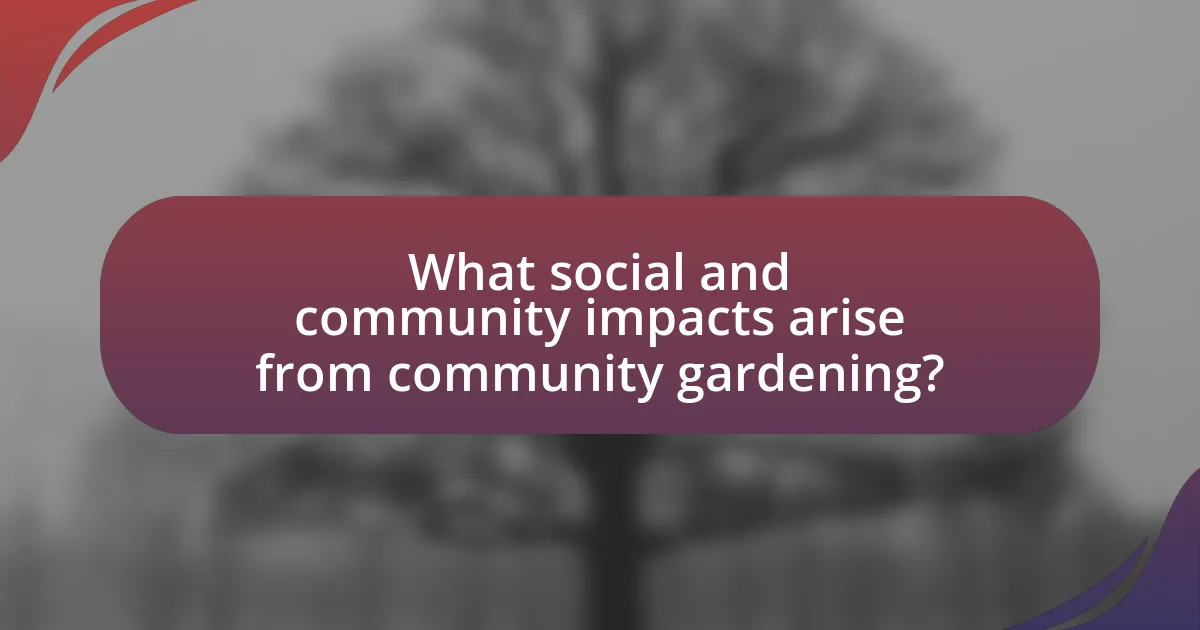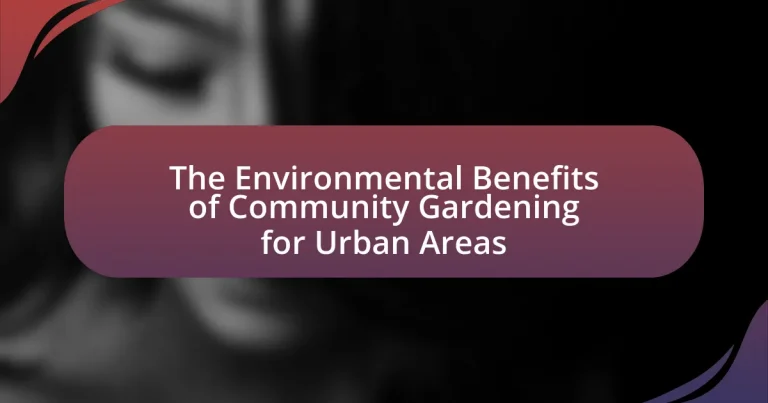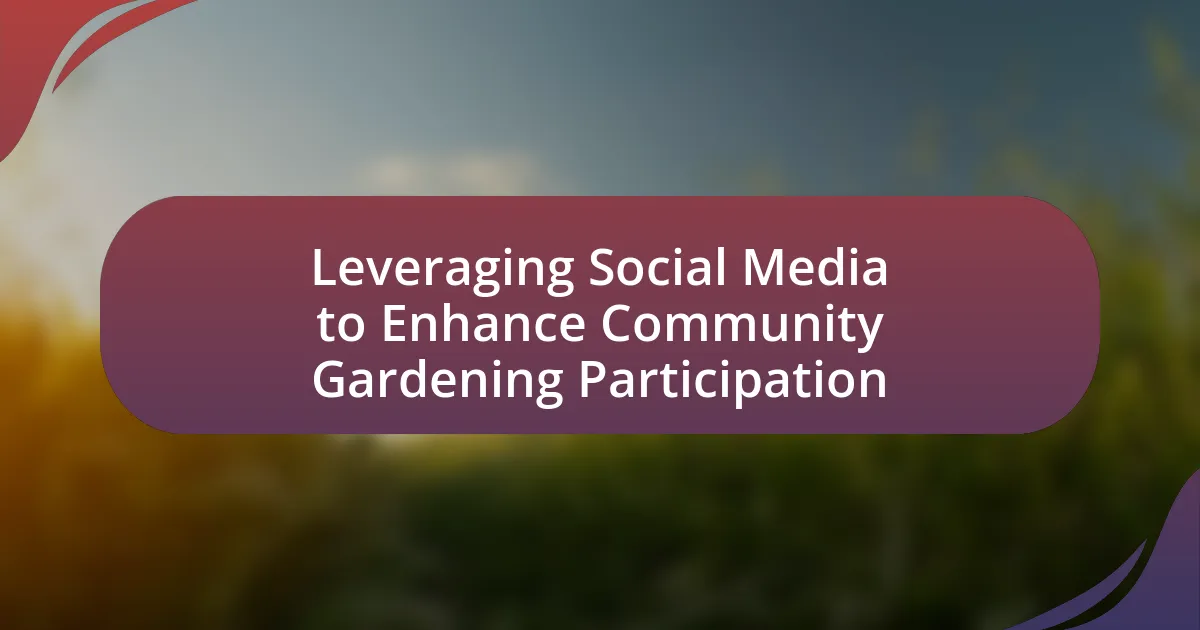Community gardening in urban areas offers substantial environmental benefits, including improved air quality, enhanced biodiversity, and effective stormwater management. These gardens contribute to cleaner air by absorbing carbon dioxide and releasing oxygen, while also providing habitats for various species, thus promoting biodiversity. Additionally, community gardens help manage stormwater runoff and mitigate urban heat, reducing surface temperatures significantly. The article explores how community gardening supports local wildlife, improves air quality, promotes sustainable practices, and fosters social cohesion, while also addressing the challenges faced by these initiatives and offering practical steps for establishing community gardens.

What are the Environmental Benefits of Community Gardening for Urban Areas?
Community gardening in urban areas provides significant environmental benefits, including improved air quality, enhanced biodiversity, and effective stormwater management. These gardens contribute to cleaner air by absorbing carbon dioxide and releasing oxygen, which is crucial in densely populated cities where pollution levels are high. Additionally, community gardens create habitats for various species, promoting biodiversity by supporting pollinators and other wildlife. Furthermore, they help manage stormwater runoff by increasing soil permeability and reducing urban heat, which mitigates flooding and lowers temperatures in urban heat islands. Studies have shown that urban green spaces, including community gardens, can reduce surface temperatures by up to 5 degrees Fahrenheit, demonstrating their effectiveness in environmental management.
How does community gardening contribute to urban biodiversity?
Community gardening enhances urban biodiversity by creating habitats for various plant and animal species. These gardens introduce native flora, which supports local pollinators like bees and butterflies, thereby increasing species richness in urban settings. Research indicates that community gardens can host up to 50% more plant species compared to surrounding areas, fostering a diverse ecosystem. Additionally, they provide food sources and nesting sites for birds and beneficial insects, contributing to a balanced urban environment.
What types of plants are typically grown in community gardens?
Community gardens typically grow a variety of plants, including vegetables, herbs, fruits, and flowers. Common vegetables include tomatoes, peppers, lettuce, and carrots, while popular herbs are basil, parsley, and cilantro. Fruits such as strawberries, raspberries, and apples are also cultivated, alongside flowers like sunflowers and marigolds, which can attract pollinators. This diversity supports local ecosystems and promotes biodiversity, contributing to the environmental benefits of community gardening in urban areas.
How do these plants support local wildlife?
Plants in community gardens support local wildlife by providing essential habitats, food sources, and nesting sites. These gardens create diverse ecosystems that attract pollinators such as bees and butterflies, which are crucial for plant reproduction. Additionally, native plants in these gardens offer seeds and nectar, sustaining various bird species and beneficial insects. Research indicates that urban gardens can increase local biodiversity by up to 30%, demonstrating their significant role in enhancing wildlife populations in urban settings.
In what ways does community gardening improve air quality?
Community gardening improves air quality primarily by increasing vegetation, which enhances photosynthesis and carbon dioxide absorption. Plants in community gardens release oxygen and filter pollutants, such as particulate matter and volatile organic compounds, from the air. Research indicates that urban green spaces can reduce air pollution levels by up to 30%, contributing to healthier urban environments. Additionally, community gardens can mitigate the urban heat island effect, which helps lower temperatures and improve air quality.
What specific pollutants can community gardens help reduce?
Community gardens can help reduce specific pollutants such as carbon dioxide, particulate matter, and nitrogen oxides. These gardens contribute to improved air quality by absorbing carbon dioxide during photosynthesis, which mitigates greenhouse gas emissions. Additionally, the vegetation in community gardens can trap particulate matter, preventing it from entering the atmosphere and reducing respiratory issues in urban populations. Studies have shown that urban greenery, including community gardens, can lower nitrogen oxides, which are harmful pollutants produced by vehicles and industrial activities, thus enhancing overall urban air quality.
How does vegetation in urban areas affect temperature regulation?
Vegetation in urban areas significantly affects temperature regulation by providing shade and facilitating evapotranspiration, which cools the surrounding environment. Trees and plants absorb sunlight, reducing the heat absorbed by buildings and pavement, thereby mitigating the urban heat island effect. Studies indicate that urban greenery can lower surface temperatures by up to 5 degrees Celsius compared to areas without vegetation, as reported in research by the U.S. Environmental Protection Agency. Additionally, the presence of vegetation can enhance air quality and reduce energy consumption for cooling, further contributing to temperature regulation in urban settings.
How does community gardening promote sustainable practices?
Community gardening promotes sustainable practices by fostering local food production, reducing carbon footprints, and enhancing biodiversity. By growing food within urban areas, community gardens minimize the need for transportation, which significantly lowers greenhouse gas emissions associated with food distribution. Additionally, these gardens often utilize organic gardening methods, which reduce reliance on chemical fertilizers and pesticides, thereby promoting healthier soil and ecosystems. Research indicates that urban gardens can increase local biodiversity by providing habitats for various species, including pollinators, which are crucial for food production. Furthermore, community gardening encourages social cohesion and environmental stewardship among participants, leading to more sustainable community practices overall.
What sustainable gardening techniques are commonly used?
Sustainable gardening techniques commonly used include composting, rainwater harvesting, crop rotation, and organic pest management. Composting enriches soil health by recycling organic waste, which reduces landfill contributions and enhances nutrient availability for plants. Rainwater harvesting captures and utilizes natural precipitation, decreasing reliance on municipal water supplies and promoting water conservation. Crop rotation prevents soil depletion and reduces pest and disease buildup by alternating plant families in a given area. Organic pest management employs natural predators and non-toxic substances to control pests, minimizing chemical use and promoting biodiversity. These techniques collectively contribute to healthier ecosystems and more resilient urban environments.
How do community gardens encourage composting and waste reduction?
Community gardens encourage composting and waste reduction by providing a dedicated space for organic waste recycling and fostering community engagement in sustainable practices. These gardens often include compost bins where residents can deposit kitchen scraps and yard waste, effectively diverting organic materials from landfills. Research indicates that community gardens can reduce waste by up to 30% through composting initiatives, as participants learn the benefits of recycling organic matter into nutrient-rich soil. Additionally, educational workshops held in these gardens promote awareness about composting techniques and the importance of reducing waste, further enhancing community involvement and commitment to sustainable practices.

What social and community impacts arise from community gardening?
Community gardening fosters social cohesion and enhances community engagement. By bringing together diverse groups of individuals, community gardens create a shared space that encourages collaboration, communication, and relationship-building among participants. Research indicates that neighborhoods with community gardens experience increased social interaction and a stronger sense of belonging, as evidenced by a study published in the Journal of Community Psychology, which found that community gardens significantly improve social ties and community involvement. Additionally, community gardening promotes food security and access to fresh produce, which can lead to improved health outcomes for residents. This multifaceted impact underscores the importance of community gardening in urban areas, contributing to both social well-being and community resilience.
How does community gardening foster social connections among residents?
Community gardening fosters social connections among residents by creating a shared space where individuals collaborate on gardening activities. This collaboration encourages interaction, communication, and relationship-building among diverse community members. Research indicates that community gardens serve as social hubs, promoting a sense of belonging and community identity. For instance, a study published in the Journal of Community Psychology found that participants in community gardening reported increased social ties and support networks, highlighting the role of these gardens in enhancing social cohesion.
What role do community gardens play in building community identity?
Community gardens play a crucial role in building community identity by fostering social connections and enhancing local engagement. These gardens serve as communal spaces where individuals from diverse backgrounds come together to cultivate plants, share resources, and participate in collective activities, thereby creating a sense of belonging. Research indicates that neighborhoods with community gardens report increased social cohesion and a stronger sense of community pride, as evidenced by a study published in the Journal of Community Psychology, which found that 75% of participants felt more connected to their neighbors after engaging in gardening activities. This shared experience not only strengthens interpersonal relationships but also contributes to a collective identity rooted in collaboration and sustainability.
How can community gardening reduce urban isolation?
Community gardening can reduce urban isolation by fostering social connections among residents. Engaging in shared gardening activities encourages interaction, collaboration, and the formation of friendships, which are essential for building community ties. Research indicates that community gardens serve as social hubs, where individuals from diverse backgrounds come together, thus decreasing feelings of loneliness and isolation. A study published in the Journal of Community Psychology found that participants in community gardening reported increased social support and a stronger sense of belonging, highlighting the role of these gardens in enhancing community cohesion.
In what ways does community gardening enhance local food security?
Community gardening enhances local food security by increasing access to fresh produce, fostering self-sufficiency, and building community resilience. By transforming vacant lots into productive gardens, communities can grow their own fruits and vegetables, which directly addresses food deserts where access to healthy food is limited. Research indicates that community gardens can produce up to 1,000 pounds of food per year on a quarter-acre plot, significantly contributing to local food supplies. Additionally, these gardens promote knowledge sharing about sustainable agricultural practices, empowering residents to cultivate their own food and reduce reliance on external food sources. This localized food production not only improves nutrition but also strengthens community ties, making neighborhoods more resilient to economic fluctuations and food supply disruptions.
How does access to fresh produce affect community health?
Access to fresh produce significantly improves community health by enhancing nutrition and reducing the risk of chronic diseases. Communities with better access to fresh fruits and vegetables experience lower rates of obesity, diabetes, and heart disease, as these foods provide essential vitamins, minerals, and fiber. For instance, a study published in the American Journal of Preventive Medicine found that neighborhoods with increased access to fresh produce saw a 32% decrease in obesity rates among residents. This correlation highlights the importance of fresh produce in promoting healthier dietary choices and overall well-being within communities.
What educational opportunities do community gardens provide?
Community gardens provide educational opportunities by offering hands-on experiences in sustainable agriculture, nutrition, and environmental stewardship. Participants learn about plant biology, soil health, and the importance of biodiversity through direct involvement in gardening activities. Research indicates that community gardens enhance knowledge of food systems and promote healthy eating habits, as evidenced by a study published in the Journal of Community Health, which found that individuals involved in community gardening reported increased fruit and vegetable consumption. Additionally, workshops and programs often hosted in these gardens teach skills such as composting, pest management, and water conservation, further enriching the educational experience.

What challenges do urban community gardens face?
Urban community gardens face several challenges, including limited access to land, funding constraints, and community engagement issues. Limited access to land often arises from high real estate prices in urban areas, making it difficult for community groups to secure suitable plots for gardening. Funding constraints hinder the ability to maintain gardens, purchase necessary supplies, and implement educational programs. Additionally, community engagement issues can lead to inconsistent participation, which affects the sustainability and productivity of the gardens. These challenges are documented in studies such as “Urban Agriculture: A Global Perspective” by the Food and Agriculture Organization, which highlights the barriers faced by urban agricultural initiatives.
What are the common obstacles to establishing community gardens in urban areas?
Common obstacles to establishing community gardens in urban areas include limited access to land, zoning regulations, and community engagement challenges. Limited access to land often arises from high real estate prices and competing land uses, making it difficult for community members to secure suitable plots for gardening. Zoning regulations can restrict the types of activities allowed on certain parcels, hindering the establishment of gardens. Additionally, engaging the community can be challenging due to differing interests, lack of awareness, or insufficient organizational support, which can impede the collaborative effort needed to create and maintain a garden.
How do zoning laws impact community gardening initiatives?
Zoning laws significantly impact community gardening initiatives by regulating land use, which can either facilitate or hinder the establishment of gardens in urban areas. These laws determine where gardens can be located, often designating specific zones for residential, commercial, or agricultural use. For instance, in cities where zoning permits community gardens in residential areas, these initiatives can thrive, contributing to local food production and green space. Conversely, restrictive zoning can limit gardening activities, as seen in cities like Los Angeles, where certain areas are not zoned for agricultural use, thereby stifling community gardening efforts. This regulatory framework directly influences the accessibility and sustainability of community gardens, shaping their role in enhancing urban environments.
What funding sources are available for community gardening projects?
Funding sources available for community gardening projects include government grants, nonprofit organizations, crowdfunding platforms, and local business sponsorships. Government grants, such as those from the U.S. Department of Agriculture, provide financial support specifically for community development and agricultural initiatives. Nonprofit organizations like the American Community Gardening Association offer grants and resources to support community gardening efforts. Crowdfunding platforms, such as GoFundMe, allow individuals and groups to raise funds directly from the community. Additionally, local businesses often sponsor community gardens as part of their corporate social responsibility initiatives, providing both financial support and resources. These funding sources collectively enhance the viability and sustainability of community gardening projects, contributing to urban environmental benefits.
How can communities overcome these challenges?
Communities can overcome challenges related to community gardening by fostering collaboration among residents, local organizations, and government entities. This collaboration can lead to shared resources, knowledge exchange, and collective problem-solving, which are essential for addressing issues such as limited space, funding, and access to gardening supplies. For instance, a study by the American Community Gardening Association found that community gardens can thrive when supported by local governments through policy frameworks that provide land access and financial assistance. Additionally, establishing educational programs can empower community members with gardening skills and sustainable practices, further enhancing the resilience of these initiatives.
What strategies have successful community gardens implemented?
Successful community gardens have implemented strategies such as establishing clear governance structures, fostering community engagement, and utilizing sustainable gardening practices. Clear governance structures, including defined roles and responsibilities, help ensure effective management and conflict resolution among participants. Community engagement strategies, such as regular meetings and inclusive decision-making processes, promote a sense of ownership and collaboration among gardeners. Sustainable gardening practices, including organic farming techniques and water conservation methods, enhance environmental benefits by improving soil health and reducing resource consumption. These strategies collectively contribute to the success and sustainability of community gardens, as evidenced by numerous case studies highlighting increased biodiversity and improved local ecosystems in urban areas.
How can community members advocate for supportive policies?
Community members can advocate for supportive policies by organizing grassroots campaigns that highlight the environmental benefits of community gardening. These campaigns can include petitions, public meetings, and collaboration with local organizations to raise awareness about how community gardens improve urban ecosystems, enhance biodiversity, and reduce urban heat. Evidence shows that cities with community gardens experience increased green space, which contributes to better air quality and stormwater management. For instance, a study by the American Community Gardening Association found that community gardens can reduce neighborhood crime rates and improve community cohesion, making a compelling case for policymakers to support such initiatives.
What practical tips can individuals follow to start a community garden?
To start a community garden, individuals should first gather interested participants to form a planning group. This group can assess potential locations, such as vacant lots or parks, and secure permission from property owners or local authorities. Next, they should create a garden plan that includes the types of plants to grow, layout, and maintenance responsibilities. Establishing a budget for supplies, such as soil, seeds, and tools, is essential, along with organizing fundraising efforts or seeking grants. Additionally, individuals should promote community involvement through workshops and events to educate participants about gardening techniques and environmental benefits. Research indicates that community gardens can improve urban biodiversity and reduce food deserts, making them valuable for local ecosystems and communities.
How can one assess the best location for a community garden?
To assess the best location for a community garden, one should evaluate factors such as sunlight exposure, soil quality, water accessibility, and proximity to the community it serves. Sunlight is crucial, as most vegetables require at least six hours of direct sunlight daily. Soil quality should be tested for contaminants and nutrient levels, as healthy soil promotes plant growth. Water accessibility is essential for irrigation; locations near water sources or with easy access to hoses are preferable. Additionally, the garden should be situated within walking distance for community members to encourage participation and maintenance. Research indicates that community gardens located in areas with high foot traffic and visibility tend to attract more participants, enhancing community engagement and sustainability.
What steps are involved in organizing a community gardening group?
To organize a community gardening group, the initial step is to gather interested individuals to form a core group. This group should identify a suitable location for the garden, ensuring it has access to sunlight, water, and soil. Next, the group must create a plan that outlines the garden’s goals, design, and maintenance responsibilities. Following this, securing necessary permissions from local authorities is essential to ensure compliance with regulations. The group should then organize community meetings to engage more participants and gather input. Finally, establishing a schedule for planting, maintenance, and community events will help sustain the garden and foster community involvement. These steps are crucial for creating a successful community gardening initiative that can enhance urban environments.





